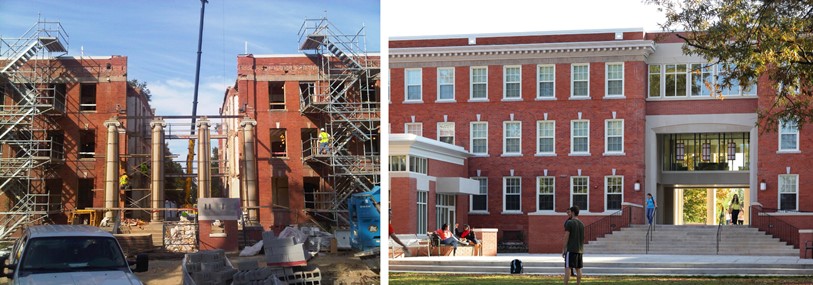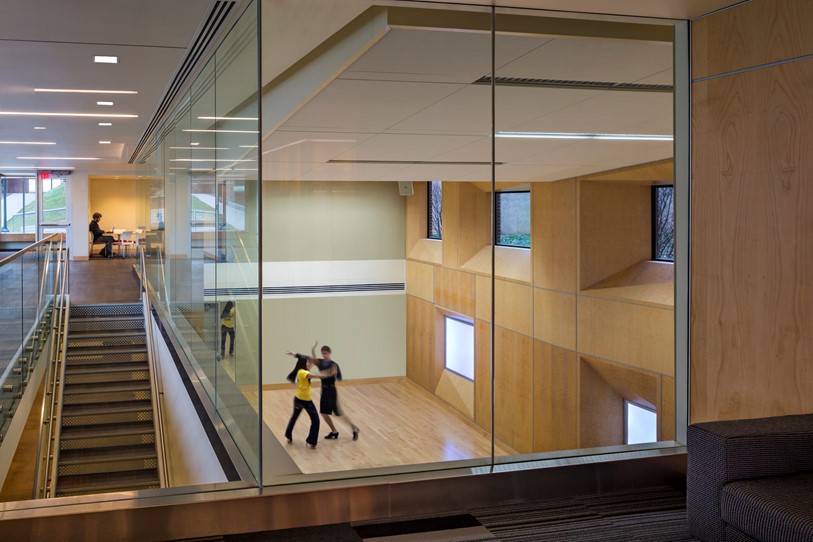Renovation is Innovation
Higher education institutions face enormous competitive pressure to provide residence halls that match or beat what competitors offer.
Yet our nation’s higher education campuses are still heavily populated with aging residence halls. The average age of a U.S. higher education facility is 40 years and many are already in their fifth decade of service, a recent study indicates.
In today’s environment, getting funding for new residence halls can be challenging. Financing is tight and student enrollments are declining in many parts of the country. That’s why many schools are looking to fund new residence halls with public private partnerships.
Renovations are also being pursued. They improve the curb appeal of residence halls, reset the clock on building lifespans and are often less costly than building new. Major renovations in residence halls run about 35 percent less than building new, assuming the same quality of building.
Renovating verses building new can also be more appeasing to local residents and alumni, especially if a building or series of buildings hold historic and cultural significance. Renovations also restrain campus creep into adjacent neighborhoods.

The historic and cultural importance of core buildings was a huge part of the decision to renovate at the University of North Carolina Greensboro a few years ago. Faced with growing enrollment, the school weighed two scenarios: raze seven residence buildings on its 90-year-old historic quad and rebuild and add capacity, or renovate. A public outcry from local preservationists and alumni resulted in renovation.
Designers re-imagined the quad to promote community and to capitalize on the quad’s proximity to an important campus axis. This involved no less than making a portal through the center of the main building, Shaw Hall, to create a direct connection to other parts of campus through the quad, while retaining the building’s historic columns and portico.
The insides of all of the residence halls were gutted and re-designed to better match the housing expectations of today’s students. Yet the buildings retained their space shaping masonry form, granite windowsills, stone work and other features. Parlors in the other six buildings, formerly one-story spaces, are now two-story volumes with a glass clerestory providing natural light.
This renovation was huge, but a far greater number of renovations are small ones. They, too, can have a big impact on the look, feel and marketability of residence halls. We’ve seen big impacts occur with small changes in residence halls via such things as:
Found Common Spaces.
Even though today’s college students have many exacting tastes, student rooms are still, for the most part, simple and utilitarian. Many older residence halls are traditionally planned with rooms lining both sides of long corridors. Removing one or two of those rooms at the ends or the middle of the hallway can create a new look and feel in the building. By turning that space into common areas, places are created for students to gather, linger, or study. These new spaces can also bring light into the hallway, which is key to improving first impressions and overall resident satisfaction.
New or Re-Designed Walkways.
Like sidewalks in neighborhood streets, walkways among and between residence halls create community, invitations to socialize and they separate private from public space. The old sidewalks in the quad at the University of North Carolina ran diagonally so there was no direct way to get from one hall to the next. They’ve since been redesigned to run in front of the halls and connect the buildings. That leaves the green space as a forum-like space for people to congregate. Extending the walkway into a patio in front of a hall, or at a side entrance, can also create spaces for students to gather and meet outside of a residence hall.
Social Corridors.
Even if you can’t widen an entire corridor, widening parts of it can create informal gathering spaces. In some residence halls, corridors are being widened from six feet to 10 feet to 12 feet around shared bathroom areas. Put a white board and chairs in that space, and students will claim it for their community for informal meetings, studying or just hanging out.
More Natural Light.

More daylight and a stronger visual connection between inside and outside were priorities for student rooms at Gateway Hall on College Hill at East Carolina University. Unusually generous windows were part of the plan from the start. Not only do the larger than normal windows deliver ample light and views, they make the building appear more friendly and inviting. They even change the look and feel of the standard-sized rooms, making them feel larger and more accommodating.
At the University of Michigan, a floor above what had been a mechanical support space was removed, creating both a day-lit two-story dance studio and a two-story lounge with glass windows, bringing natural light into what was once a dark utility space. The positive impacts of natural daylight on student health and performance has been well documented, and the residence hall, like one’s living room back home, is a good place for it.
Fewer Walls.
Anybody who’s renovated a parceled traditional house knows how much more light, bright and open a space can feel when a few walls come down. In res-life spaces, taking down walls and opening things up makes way for easier circulation flow. That increases chances for student interactions. Sharing circulation among spaces also creates more useable area. Common areas that now include open kitchens that flow into living rooms make college and university residence halls truly feel more like home.
Sometimes, less is more
Some schools are even opting for designs that favor student connection over student convenience. The New Mexico Institute of Mining and Technology opted to take sinks out of the suites in its newest residence hall, Torres Hall, so that it could capture and repurpose the area and the funds to construct a living-learning multi-purpose room. The room, the first of its kind on campus, is now heavily used.
Overall, we see continued pressure on schools to do more with less, and to extend the lifespans of residence halls that are often crucial assets to the core of campuses. The good news is that renovations - whether modest or extensive, with inside or outdoor space, and either subtractive or additive - can often do the job.
